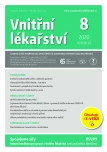Bariatry – surgical therapy of the severe obesity
Authors:
Mojmír Kasalický 1,2
Authors‘ workplace:
Chirurgická klinika 2. LF UK a ÚVN, Praha
1; Fakulta zdravotníctva a sociálnej práce, Trnavská univerzita
2
Published in:
Vnitř Lék 2020; 66(8): 472-477
Category:
Main Topic
Overview
When conservative therapy of the morbid obesity repeatedly fails bariatric surgery begins. Adults patients from 18 to 60 age with obesity 3rd grade (BMI > 40 kg/m2 ), respectively 2nd grade (BMI > 35 kg/m2 ), with symptomatic diseases caused by obesity as type 2 diabetes, hypertension, dyslipidaemia or heavy failure of the joints, in which conservative therapy failed, are indicate for bariatric surgery. Nearly all of the bariatric procedures are providing by laparoscopy at present. Contemporary bariatric surgery is using restrictive or malabsorptive or combination of both operating methods. Adjustable gastric banding and vertical gastric plication are pure restrictive bariatric method. The most popular restrictive method with partial hormonal effect is sleeve gastrectomy at present. Biliopancreatic diversion is considered to be a pure malabsorptive bariatric method. Majority of the bariatric surgeons consider gastric bypasses as malabsorptive restrictive method.
Keywords:
bariatric methods – diabetes – obesity
Sources
1. Angrisani L, et al. (2015). Bariatric Surgery Worldwide 2014. Obes Surg, 25(10): 1822–1832.
2. Navarrete SA, Leyba JL, et al. Laparoscopic sleeve gastrectomy with duodenojejunal bypasses for the treatment of type 2 diabetes in non‑obese patiens: technice and prelimitary results. Obes Surg 2011; 5 : 663–667.
3. Kasalický, M. Bariatrie, chirurgická léčba obezity a cukrovky, 2018, Maxdorf Praha, ISBN 978-80-7345-593-4.
4. Buchwald H, Estok R, Fahrbach K, et al. (2019). Weight and type 2 diabetes after bariatric surgery: systematic review and meta‑analysis. Am J Med,122 : 248–256.
5. Buchwald H, et al. Metabolic Surgery. New York, Grune a Stratton, 1978.
6. Kasalicky M. (2012). Pohled na současnou bariatricko‑metabolickou chirurgii. Rozhl Chir, 91(1): 5–11.
7. Di Lorenzo N, Antoniou SA, Batterham RL, el al. Clinical practice guidelines of the European Association for Endoscopic Surgery (EAES) on bariatric surgery: update 2020 endorsed by IFSO‑EC, EASO and ESPCOP. Surg Endosc 2020, DOI 10.1007/s00464-02007555-y. ISSN 0930-2794.
8. Fried M, Gryga A, Herlesova J, et al. Obecné indikace a kontraindikace k bariatrii. Roz ‑ hl Chir 2013; 92 : 41–44.
9. Benedix F, Westphal S, Patschke E, et al. Weight Loss and Changes in Salivary Ghrelin and Adiponectin: Comparison Between Sleeve Gastrectomy and Roux‑en‑Y Gastric Bypass and Gastric Banding. Obes Surg, 2011; 21 : 616–624.
10. Ramos A, Neto MG, Galvao M, et al. Laparoscopic great curvature placation: Initial results of an alternative restrictive bariatric procedure. Obes Surg 2010; 20 : 913–918.
11. Gagner M, Hutchinson C, Rosenthal R. (2016). Fifth International Consensus Conference: current status of sleeve gastrectomy. Surg Obes Relat Dis, 12 : 750–756.
12. Scopinaro N, Adami FG, Papadia FS, et al. The effects of biliopancreatic diversion on type 2 diabetes mellitus in patients with mild obesity (BMI 30–35 kg/m2 ) and simple overweight (BMI 25–30 kg/m2): A prospective controlled study. Obes Surg 2011; 21 : 880–888.
13. Benedix F, Westphal S, Patschke E, et al. Weight Loss and Changes in Salivary Ghrelin and Adiponectin: Comparison Between Sleeve Gastrectomy and Roux‑en‑Y Gastric Bypass and Gastric Banding. Obes Surg, 2011; 21 : 616–624.
14. Benedix F, Westphal S, Patschke E, et al. Weight Loss and Changes in Salivary Ghrelin and Adiponectin: Comparison Between Sleeve Gastrectomy and Roux‑en‑Y Gastric Bypass and Gastric Banding. Obes Surg, 2011; 21 : 616–624.
15. Singla V, Aggarwal S, Singh B, et al. Outcomes in super obese patients undergoing one anastomosis gastric bypass or laparoscopic sleeve gastrectomy. Obes Surg. 2019; 29(4): 1242–1247.
16. Sinclair P, Docherty N, et al. Metabolic Effects of Bariatric Surgery. Clin Chem. 2018; 64(1): 72–81. DOI: 10.1373/clinchem.2017.27233.
17. Bradnova O, Kyrou I, Hainer V, et al. Laparoscopic greater curvature plication in morbidly obese women with type 2 diabetes: effects on glucose homeostasis, postprandial triglyceridemia and selected gut hormones Obes Surg 2014; 24(5): 718–726. doi: 10.1007/ s11695-013-1143-4.
18. Sjöström L, Lindroos AK, Peltonen M, Torgerson J, Bouchard C, Carlsson B, et al. Lifestyle, diabetes, and cardiovascular risk factors 10 years after bariatric surgery. N Engl J Med. 2004; 351(26): 2683–2693.
19. Sjöström L, Narbro K, Sjöström CD, Karason K, Larsson B, Wedel H, et al. Effects of bari ‑ atric surgery on mortality in Swedish obese subjects. N Engl J Med. 2007; 357(8): 741–752.
20. Nocca D, Guillaume F, Noel P, et al. Impact of laparoscopic sleeve gastrectomy and la ‑ paroscopic gastric bypass on HbA1c blood level and pharmacological tratment of type 2 diabetes mellitus in severe or morbidly obese patiens. Results of a multicenter prospective study at 1 year. Obes Surg 2011; 21 : 738–743.
21. De Luca M, Angrisani L,Himpens J. Indications for Surgery for Obesity andWeight‑Related Diseases: Position Statements from the International Federation for the Surgery of Obesity and Metabolic Disorders (IFSO). Obes Surg, 2016 : 1659–1696. DOI 10.1007/ s11695-016-2271-4.
Labels
Diabetology Endocrinology Internal medicineArticle was published in
Internal Medicine

2020 Issue 8
Most read in this issue
- Dialysis patient in internal medicine inpatient ward
- Obesity-associated changes in drug pharmacokinetics
- Heparin induced thrombocytopenia and up to date options of treatment – review of literature
- Danger of the sea‑complications After Scorpion Fish Attack
